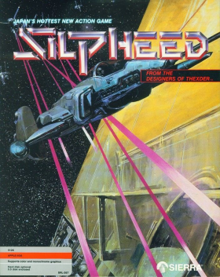
Back Silpheed Danish Silpheed French Silpheed Italian シルフィード (ゲーム) Japanese 실피드 (비디오 게임) Korean Silpheed LLD Silpheed Dutch Silpheed Swedish
This article needs additional citations for verification. (October 2010) |
| Silpheed | |
|---|---|
 Apple IIGS / DOS cover art | |
| Developer(s) | Game Arts (PC-8801, FM77AV, Sega CD) Sierra On-Line (Apple IIGS, TRS-80 CoCo, DOS) |
| Publisher(s) | Game Arts (PC-8801, FM77AV) Sierra On-Line (Apple IIGS, TRS-80 CoCo, DOS) Sega (Sega CD) |
| Director(s) | Takeshi Miyaji |
| Producer(s) | Yoichi Miyaji Toshiyuki Uchida |
| Designer(s) | Takeshi Miyaji Masakuni Mitsuhashi Osamu Harada |
| Programmer(s) | Satoshi Uesaka Nia Necoyama Akira Eye Tomoyuki Shimada |
| Artist(s) | Satoshi Uesaka Nobuyuki Ogawa Akira Eye |
| Composer(s) | Fumihito Kasatani Nobuyuki Aoshima Masakuni Mitsuhashi Hibiki Godai |
| Platform(s) | PC-8801mkII SR, FM-77AV, Apple IIGS, TRS-80 CoCo, DOS, Sega CD |
| Release | |
| Genre(s) | Third-person shooter |
| Mode(s) | Single-player |
Silpheed (Japanese: シルフィード, Hepburn: Shirufīdo) is a video game developed by Game Arts and designed by Takeshi Miyaji.[1] It made its debut on the Japanese PC-8801 in 1986, and was ported to the Fujitsu FM-7 and DOS formats soon after. It was later remade for the Sega CD and has a sequel called Silpheed: The Lost Planet for the PlayStation 2.
Silpheed is the name of the spacecraft that the player controls, and is most likely derived from the famous ballet, La Sylphide. Like many shooter games, the story involves using the Silpheed as Earth's last effort to save itself from destruction by a powerful enemy invasion. The original 1986 PC-88 version used 3D polygonal graphics on top of a tilted third-person backdrop.[2] The 1993 Sega CD version later used pre-rendered computer animation as a full motion video background, a technique previously used by the Namco System 21 arcade game Galaxian 3.
- ^ "Silpheed designer dies aged 45". Edge. Next-Gen.biz. August 1, 2011. Archived from the original on 2012-12-31. Retrieved 3 August 2011.
- ^ "{title}". Archived from the original on 2014-11-01. Retrieved 2014-10-07.